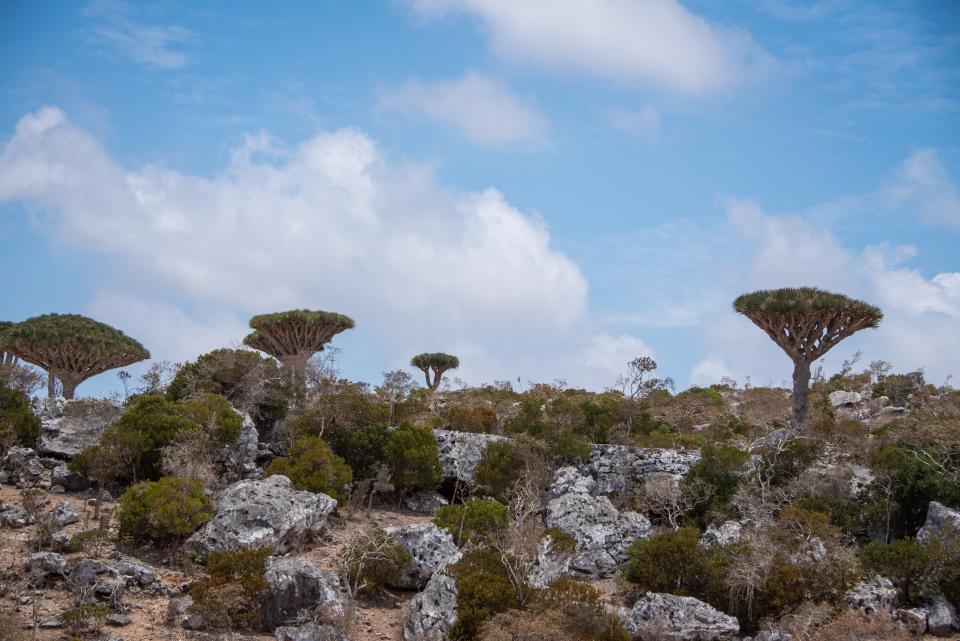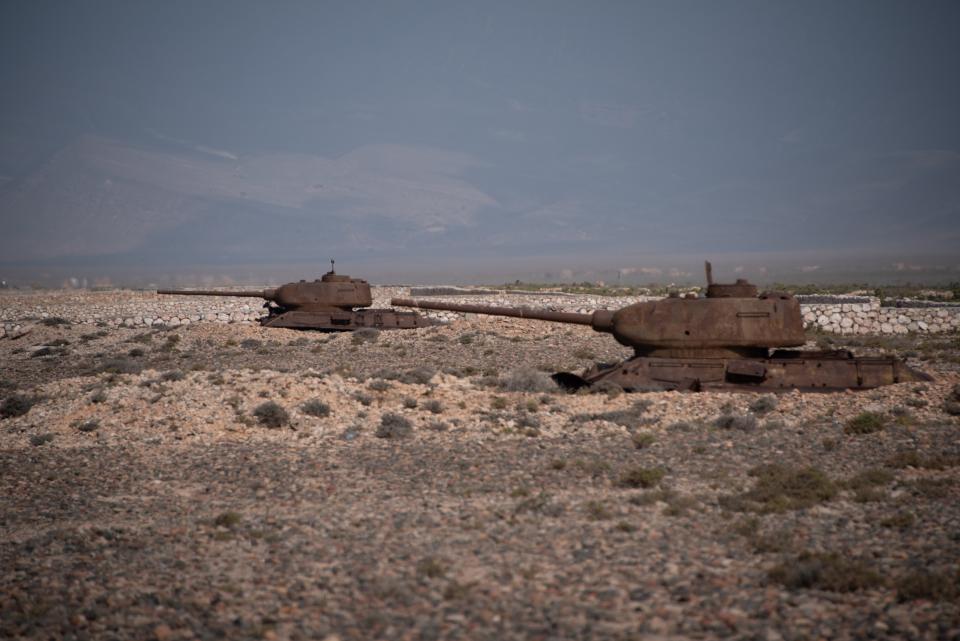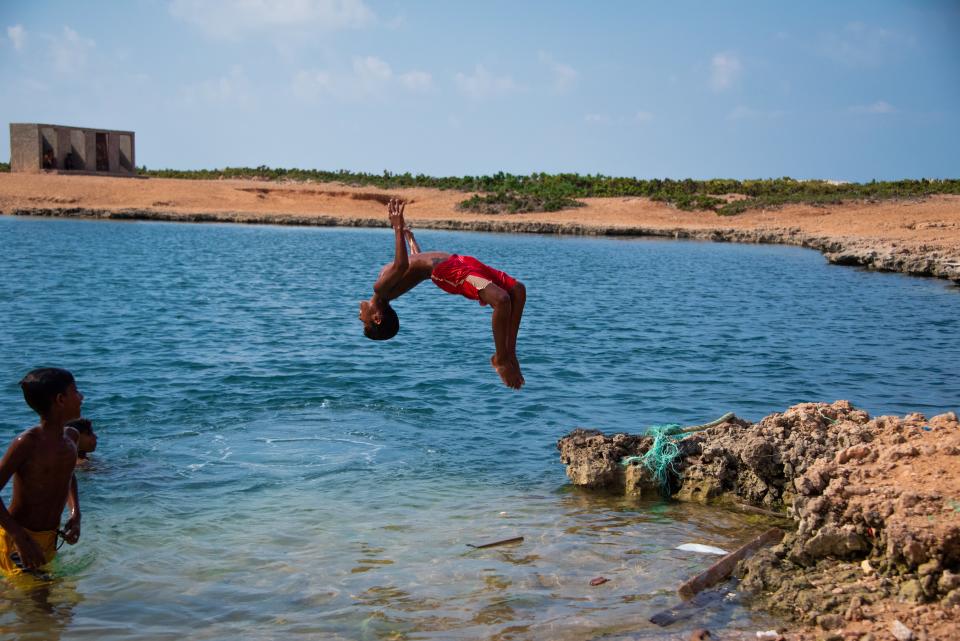‘This is a forgotten island’: The remote Yemeni territory that hopes to become an ecotourism hotspot

A Dragon’s Blood Tree on the Diksam Plateau
(Valentina Morriconi)From landing on a beach airstrip to the bumpy drive to a remote village, a 360m-climb in the blazing sun, and then the eerie blackness of a stalactite-filled cave with millennia-old etchings, our group’s overwhelming feeling to be on Socotra was one of privilege.
The Hoq Cave yawned open, with its pitch-black interior stretching 3km deep into the summit of the mountain we had just climbed. Inside was evidence of what makes our destination so special: cave writing and painting in ancient languages from regions as diverse as India and southern Africa. This island has been visited by the oldest of civilisations, yet today it is considered one of the most off-road destinations there is.
The island of Socotra, part of Yemen’s Socotran Archipelago, has long been a niche obsession for travel enthusiasts and academics. Its unique species, breathtaking, undeveloped landscapes and iconoclastic local culture have earned it the nickname “the Galapagos of the Indian Ocean”. Bloggers have called it the Arabian Sea’s hidden jewel, or “the most alien-looking place in the world”.
Over four days we discovered its wild beaches, explored its ancient cultural heritage and met with locals to hear about their lives and hopes for their homeland. We also came to learn about the conservation of its remarkable ecosystems and the development of the little-known region as a tourist destination.
Officially part of war-torn Yemen, the island, awarded UNESCO heritage status in 2008, is geographically closer to Somalia on the African mainland and politically closer to the oil-rich kingdoms of the Arabian Peninsula. The name ‘Socotra’ is either translated as ‘paradise’ or ‘emporium of resin’.
What we learnt was that there are, in effect, two Socotras to visit. There is the almost mythological island with its Martian landscapes, endemic plant and animal species and natural history. Then there is the Socotra of modern Yemen, with all the associated challenges of isolation and dependence on foreign assistance.
The Yemeni mainland has, since 2014, been rocked by a brutal civil war that began when the Iranian-backed Houthi opposition overthrew the government and seized the capital Sana’a. The Saudi-led intervention, with the backing of the UAE and Western countries including the US and UK, aims to restore the internationally recognised government.
Deputy Governor Salehali Alsoqatri met us to explain the state of the island. He told us that the islanders have consequently found themselves “between a rock and a hard place” with the civil war on the mainland and Covid-19. “This is a forgotten island and no one has paid attention to it”, he said.
“Low incomes in this area are a result of the war going on in the mainland and the intervention of the Houthis,” added the deputy governor. “The people on the mainland are suffering and so the people of Socotra are suffering as well.”

Yemen is now the world’s worst humanitarian crisis according to UNICEF, with around 80 per cent of the population (24 million people) in need of urgent assistance. Yet 375 kilometres south in the Arabian Sea, the only evidence of the war we saw was the occasional military checkpoint, manned by bored-looking young men in camping chairs.
The island has scant tourist infrastructure, with just one simple hotel in the capital Hadiboh, a small town lined with shops selling spices, groceries, local clothes and perfumes. The biggest restaurant, Shabwah, serves fresh grilled fish and local delicacies – including a delightfully moreish cake made from flaky dates, thick cream and Socotri honey.
Travellers tend to camp around the island, staying on locals’ land as they hike, climb and swim through various natural attractions. But even this meagre source of revenue has dried up. Before 2010 around 2,000 tourists visited Socotra each year; in the last 12 months just 120 were able to come.
The UK government is one of many that now warns its citizens to stay away. Its official advice reads: “The Foreign, Commonwealth & Development Office advise against all travel to Yemen. This includes the mainland and all islands. If you’re in Yemen, you should leave immediately.”
The war aborted any plans for development of the island’s tourism industry. The deputy governor said there were currently no tourism projects with planning permission. Anyway, he saw the future of the tourism industry as Masai Mara-style fly camps rather than five-star hotels. Indeed, he urged any companies with the vision and experience to cater to the conditions on the island to come forward.
Fly camp tourism has its advantages. They are low-maintenance and do not have huge energy or infrastructure needs, which could threaten pristine natural reserves. The locals we met who accepted visitors referred to them by the central tourism office onto their land, were delighted to play host and earn some additional money.
Rumours of the Emiratis’ plans to turn the place into the ‘Ibiza of Arabia’ have turned out to be unfounded, and a Kuwaiti businessman who allegedly planned to build a luxury hotel on the coast has disappeared.
The northern coast of Socotra boasts diverse marine life and expansive but weathered coral reefs. One of its most photogenic locations is the Detwah Lagoon, with sandy dunes and beaches as white as any in the Caribbean, and dolphins leaping across the horizon.
We swam at sunset across the lagoon; the water was wonderfully warm with a rich blue hue. Locals waved to us from their seaside huts – we later joined one family for a cup of sweet black tea as they broke their Ramadan fast.

Mohammed Nasim, 37, is the director of one of the marine reserves on the island, situated close to the lagoon. He lamented the end of tourism revenue on the island. “Conservation work has become a lot harder since the civil war. We used to host 30-60 tourists per day at the reserve”. Now the lack of infrastructure and visitors has made his job almost impossible. “We’re not trying to establish big hotels here. We are still trying to protect the natural diversity of the area”, he adds.
Socotra, perhaps more so than the mainland, has a long history of receiving foreign powers with their own economic and political intentions. The Romans coveted the red sap of the umbrella-shaped Dragon’s Blood Trees, which are now almost synonymous with the island’s image, as war paint for their gladiators. Stradivarius is said to have used it to finish his violins. In the 19th century, Britain intended to use the place as a naval base from which to patrol the strategically-important Gulf of Aden, before opting for Aden itself.
Now, talk abounds of regional powers taking an interest in Socotra. Our group from The Independent was there on the invitation of the Saudi Arabian mission, whose representatives accompanied us on our visit. They told me that there were no military operations and that their small-scale presence was to assist the local community and to support the work of the Saudi Development and Reconstruction Program for Yemen (SDRPY).
They highlighted how they were investing in a province long ignored by the Yemeni government Sana’a, and were building four new schools, refurbishing the local hospital and furnishing it with an ambulance, and connecting 45,000 people (out of a population of 60,000 on the island) to running water, where before many were dependent on wells.
And contrary to reports that the UAE planned to turn the island into a military base or holiday destination, a spokesman for the SDRPY told us that there were only six Emiratis on the island – all apparently working in the humanitarian sector.
The rusting Soviet T-53 tanks that remained stationed across the coastline between Hadiboh and Qalansiyah served as a reminder that this isolated and bizarre island has long appeared on maps with a bullseye over it, and as a relic of foreign interventions past.
Despite such a history, it was apparent that many Socotris had a great deal of goodwill towards the latest foreign power to step onto their island. Often as we drove through remote villages, where the houses were built from stone, wood and concrete, all with beautifully ornate doors, children would come running out shouting “hello Saud”.
One tribal chief in a village close to the Diksam Plateau, renowned for its views over the Wadhi Dirhur gorge – a sheer limestone canyon reminiscent of a lunar crater - and of acres of Dragon’s Blood Trees, expressed his gratitude for the humanitarian support. His son is applying for one of the scholarships offered to undertake his university studies in Saudi Arabia.
Sheikh Modammad Salem al-Keabany, 55, told us over a cup of tea that although his community had not experienced famine like has befallen many of their fellow countrymen on the mainland, the fall in the oil price (a crucial source of revenue for the Yemeni state) and the decrease in trade flows from Aden to Socotra as a result of the ongoing conflict have put economic pressure on islanders, especially due to the increased scarcity of fuel.
During our visit to the island, which is the size of New York’s Long Island or Cornwall in the UK, we encountered only two other groups of tourists, both compromised of Europeans and North Americans who flew in on the sole commercial flight, from Abu Dhabi.

One group was in camping in Qalansiyah, the second largest town on the island, after hiking and wild camping in the mountains in the centre of the island for a few days. They were all employed by a UN agency and based in Somalia or Yemen.
One visitor, Daniel Norfolk, originally from Canada, told me over the phone that he was drawn to how “off the grid” the place was. “It’s one of those fabled places, closer to the Somali mainland than to Yemen, sandwiched between these two tragic situations and it’s this spot of tranquillity”.
“I didn’t know there was such variety from the coast up to the mountain peaks. We found it a magnificent break…moving through different terrain: hiking, swimming snorkelling.” He added “The Socotri people have this awesome sense of humour. People are chilled. We’re just worlds apart”, he said.
One of his highlights was the Homhil reserve, specifically the trek through rocky outcrops, dried river rapids and rare native Aloe Vera bushes aside rows stumpy pinkish bottle trees. At the end of the climb, which took us about 30 minutes, emerges a cliff edge with a naturally forming infinity pool fed by a waterfall. The greenish-blue fresh water is bracing and delightful.
Like others, Norfolk did not foresee a future for mass tourism on the island. “No major tour companies can deal with how underdeveloped the infrastructure is”. He managed to visit the island through the bespoke agency ‘Welcome To Socotra’, which was founded by two Italians who visited
One of them, Nicolò, wrote to me over WhatsApp (there is virtually no phone signal and WiFi connections tend to be weak) to say “the uniqueness of this place brought us here and we know it’s the same for the intrepid travellers that decide to join our tours to discover the island”.
He emphasised the “eco-tourism” and “sustainability” aspect of the trips, but admitted the island was not being well preserved. “Unfortunately, nowadays given the current situation and lack of government there are no ongoing [conservation] activities. As you can imagine, it’s not a priority for them,” he wrote.
This is clear to see. Rubbish, mostly plastic bottles, is strewn across the winding roads between towns and into the mountains. Goats, wild or part of farmers’ herds, roam the territory grazing on rare plants (37 per cent of Socotra’s plant species do not grow anywhere else in the world) including the legendary Dragon’s Blood Tree, which takes hundreds of years to grow from a sapling, and has almost been confined to just the highest plateaus and secure nurseries on the island.
And while the island remains a UNESCO heritage site, the organisation warns: “Whilst the property’s terrestrial and marine habitats are generally still in good condition, management planning needs to deal more effectively with current threats including roading, overgrazing and overharvesting of terrestrial and marine natural resources. Potential future threats include unsustainable tourism and invasive species.”

Yet for now, the attraction of the island remains its sheer rawness. It has the history to match Tanzania’s Zanzibar and the beaches to rival Lamu in Kenya – both tourist hotspots further south in the Indian Ocean, but the warmth of its locals and both the diversity and proximity of its natural reserves make it exceptional.
Our guide, Adham Abdullah, who wisely avoided the 10km hike to the Hoq caves in the midday heat, said he was grateful for the Emirati and Saudi investment in his birthplace, but remained cautious about the island’s future as a luxury tourist destination, preferring the raw experience many treasure.
“Six or seven years ago, the electricity only ran from 5am to 5pm. Now it’s 24 hours”, he explained. “What makes Socotra so special is its natural environment. We’re only missing small things, like hotels and restaurants”.

 Yahoo Finance
Yahoo Finance